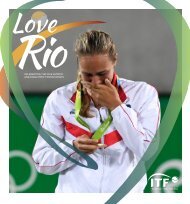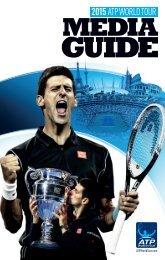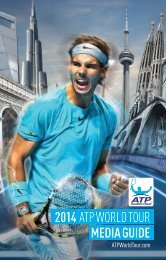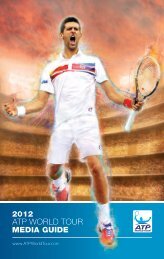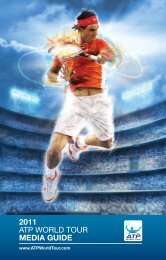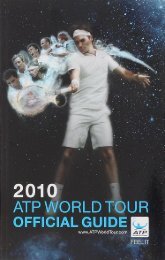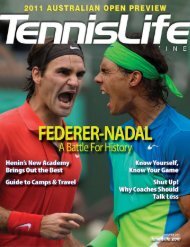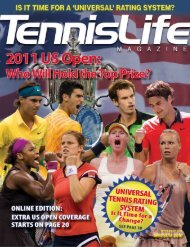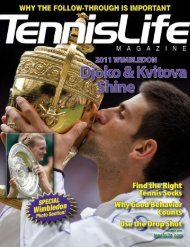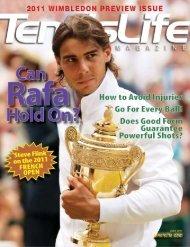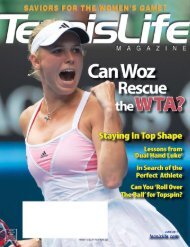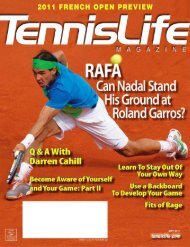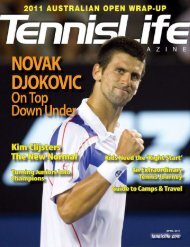A Champion's Mind - Pete Sampras
www.tennismoscow.me Insta:TENNISMOSCOW
www.tennismoscow.me Insta:TENNISMOSCOW
You also want an ePaper? Increase the reach of your titles
YUMPU automatically turns print PDFs into web optimized ePapers that Google loves.
Courier briefly snatched back the world number one ranking in August of 1993, benefiting from the<br />
points-based computer ranking system just like I had back in April. But by September, I had the top spot<br />
back again, and this time I would hold it for more than a year and a half. I felt that I was the man in<br />
command and, with Tim encouraging me to show it, I made an effort to cultivate an aura of invincibility. I<br />
became more and more averse to demonstrating any kind of weakness.<br />
For the rest of 1993, I was always in the hunt. I lost a few big matches: Goran Ivanisevic, my<br />
Wimbledon rival, tagged me on the fast carpet at the Paris Indoors in the quarters. I got my revenge a few<br />
weeks later in the ATP year-end championships, although I lost the final to Michael Stich. That surprised<br />
many pundits, but Stich was the player whose arsenal scared me the most. He had a great second serve, he<br />
could do anything, including serve and volley, and he moved easily and naturally. Those qualities,<br />
combined with the fact that he was playing before his countrymen in Germany, proved too much for me to<br />
handle.<br />
In my last event of the year, the Grand Slam Cup, I lost a whale of a final to the emerging Czech player<br />
Petr Korda. The match went to 13–11 in the fifth (the tournament had no fifth-set tiebreaker), and Korda<br />
picked up the whopping $2 million check.<br />
Down in Australia for the start of 1994, I played my first two matches and then came up against a<br />
newcomer from Russia, Yevgeny Kafelnikov. People had warned me about this tall, rangy kid with strawblond<br />
hair, a jack-o’-lantern grin, and a high-quality two-handed backhand. His forehand was one of the<br />
all-time ugly shots in tennis; he hit it with a bent arm and it looked really ungainly, especially in<br />
comparison to his smooth, sweet backhand.<br />
But that forehand was a better shot than it looked, and the guy had plenty of talent—enough to push me,<br />
hard. What’s worse, I never did very well with guys I hadn’t played before. What advantage I had in<br />
terms of my reputation was offset by the fact that it usually took me a match or two to figure a guy out, and<br />
get into a comfort zone against his unique game.<br />
But I survived Kafelnikov, then beat Ivan Lendl and got my old friends Jim Courier and Todd Martin,<br />
back to back, in the semis and finals. I rolled through Todd in straight sets to win my third major in a row.<br />
I was on fire. Next I won the two big U.S. winter hard-court events, Indian Wells and Key Biscayne. I<br />
began to sense that people were a little in awe of me, a little fearful, and I liked that feeling.<br />
From Miami, I went to the Far East to play the mini–hard court circuit that had grown up around Osaka<br />
and Tokyo. Tennis may be booming in Asia now, but at that time it was tough for promoters in that part of<br />
the world. In order to attract top players, they had to offer appearance fees in addition to whatever prize<br />
money was at stake that sometimes went into mid-to-high six figures if the player agreed to play at least<br />
two events.<br />
I never did anything just for the money. Part of it was that I was lucky—I didn’t need to. But part of it<br />
was also that bad things can happen if you just chase the dough in exhibitions or tournaments that you<br />
wouldn’t bother playing if it weren’t for those appearance fees. Those bad things include burnout, injury,<br />
mental fatigue—all of which can affect your performance later in tournaments that really count, and as the<br />
year grinds on. At times I pulled out of events where I was getting an appearance fee because I didn’t feel<br />
I could give my best effort (usually for physical reasons).<br />
In my case, playing in Asia was appealing because I was in no hurry to get to Europe to play on the red<br />
clay. From the get-go, clay was a crapshoot for me, and my results showed little correlation between the<br />
time I spent playing clay events and my results in the red-dirt tournaments that most counted. In Europe<br />
that spring of 1994, I put up the best clay-court result of my career, winning the Italian Open on the golden<br />
clay courts of the Foro Italico in Rome. At the time, the Italian featured the fastest clay courts you could<br />
find, which helps explain how I came to play the Wimbledon icon Boris Becker in the final. But along the



